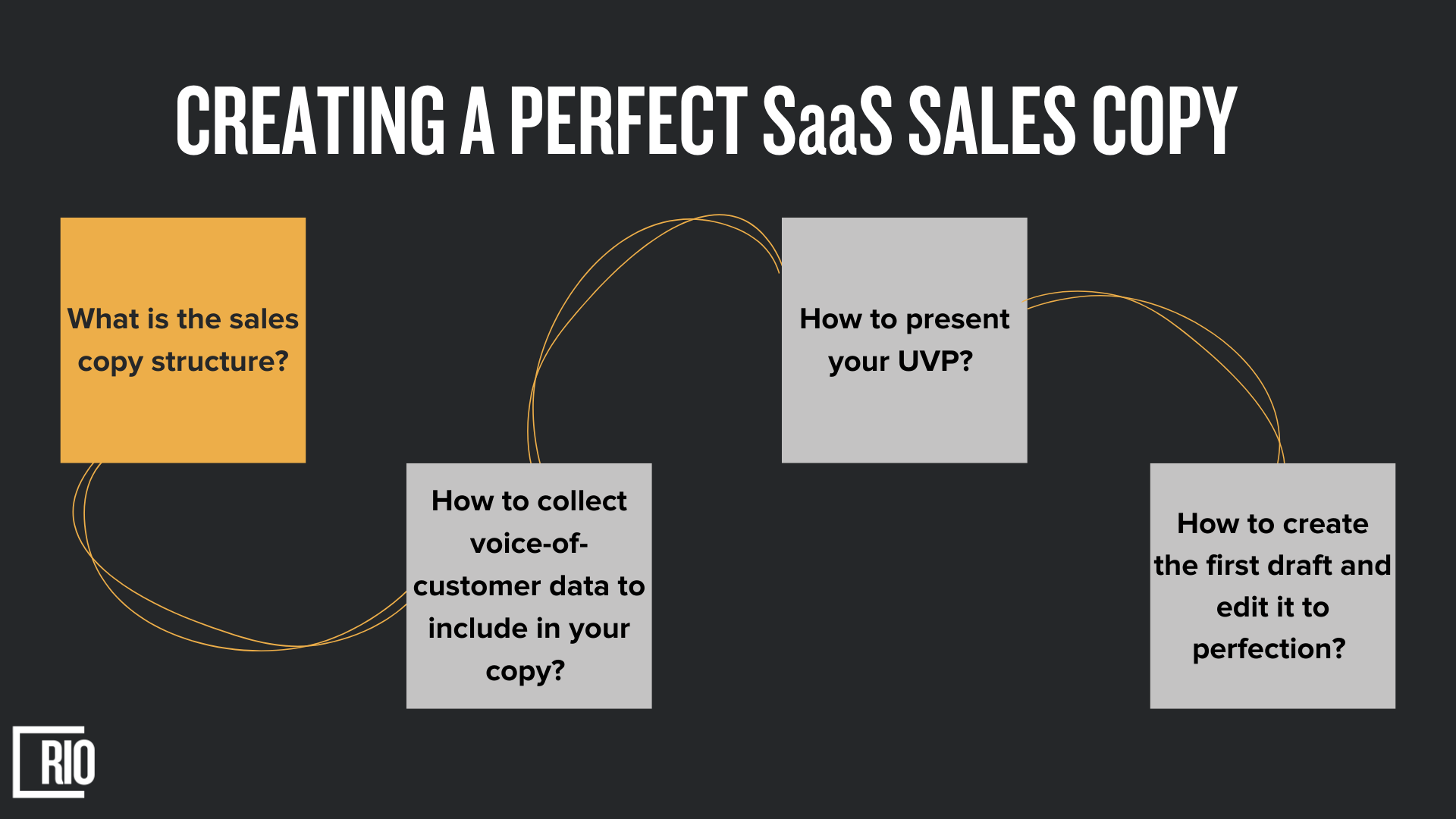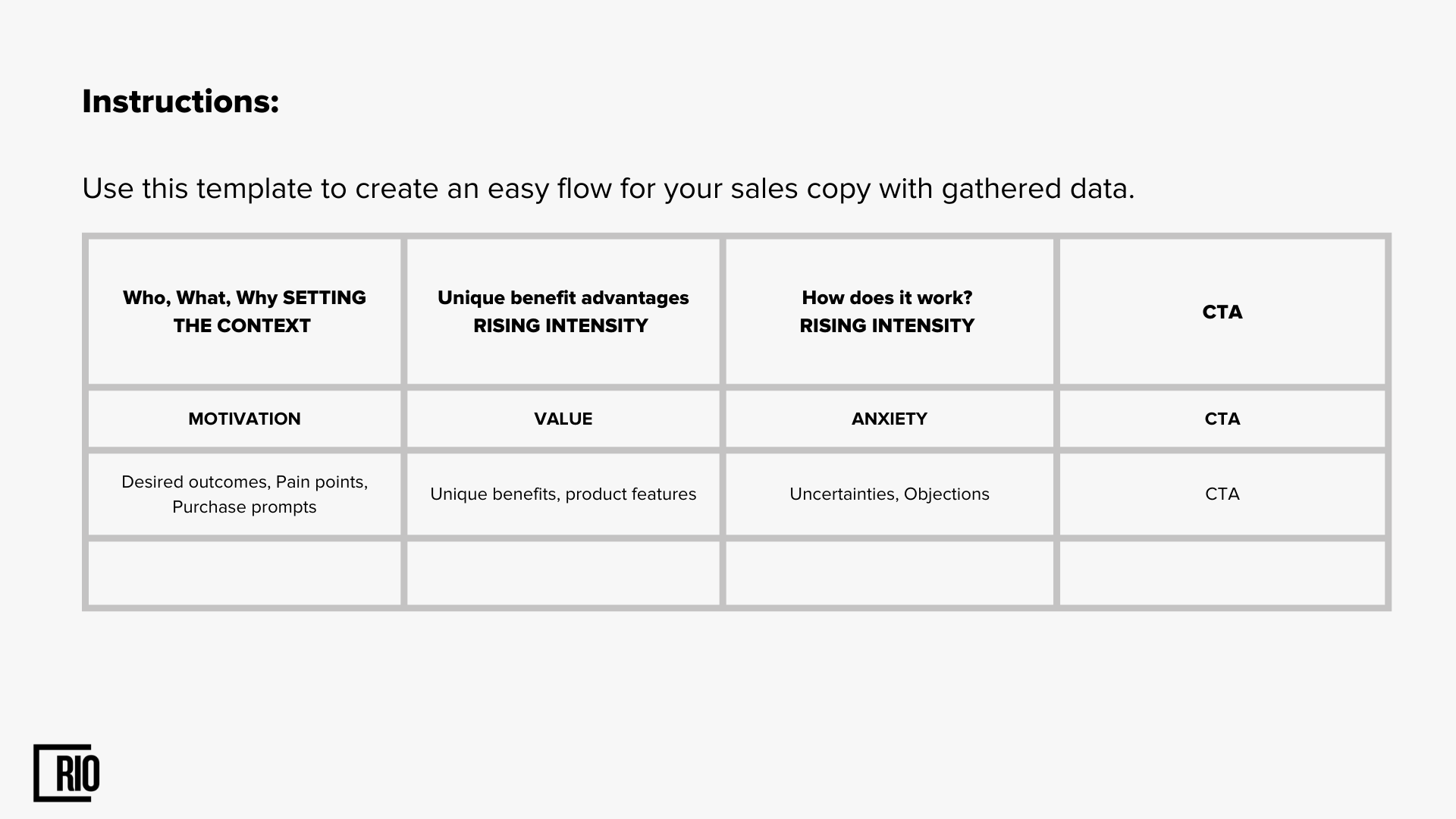This is the first article in the series. Here is a quick overview of the topics covered in each article:

It's hard to capture your prospect's interest and it's easy to lose their attention after the first few words of your sales copy. But if the prospect won't read our copy we won't be able to even try to make them buy.
In this article, we will learn how to make sure that the prospect will at least read our copy and may decide to consider our solution.
You don't need to have copywriting skills or spend a lot of time learning how to write. All you need to do is to make sure that your copy addresses all customer’s pains, desires, & anxieties and does it in the right order. You can do that by following key elements of convertible sales copy and following the message hierarchy to create a persuasive and engaging message.
Worksheets are available to download later below.
What Are The Key Elements of Your Sales Copy?
We can go over and over the necessary things you should absolutely include in your copy, but sometimes it may seem like we need or are about to include too much. Everything seems important, every word and every sentence, but here it’s necessary to recognize what are those elements, and what is really crucial for a successful and convertible copy.
So, let me introduce you to really-necessary-and-crucial elements that you absolutely need to include in your text:
MECLabs Conversion Heuristic Formula
C= 4M+3V+2(I-F) -2A
The MECLABS Conversion Sequence Heuristic is a framework of five factors on which to focus your optimization energy. It brings discipline, rigor and sustainable success to your copy.
- C - this stands for our probability of conversion.
And right after this, we can see five principal components that you need to address in your copy. Let’s break them down one by one:
- M - Motivation. It’s all about when and why your prospect decided to open your page or your message and what they expect to get from you.
We always have a reason in mind when we close/open web pages, right? Prospects are the same, they always have expectations while opening your page. This isn’t something that you can control but it’s something you need to recognize and understand thoroughly. When you understand the prospect’s motivation then you can align your message with it.
- V - Value proposition.
- I-F - Incentive & friction and those two are combined. How do you motivate prospects to act? Are you making it hard for them to buy/give you their contact info?
- A - Anxiety. People are always worried and your task is to reduce those worries as much as possible.
Now it’s time to address why all of these letters have numbers before them and the answer is easy: it’s the level of importance of each element. Each of these factors creates an ultimate recipe for a perfect copy, that will influence your prospect to act.
Motivation is perceived as more important than the value you can offer. Value is still uber-important, though. That means what the prospect can actually get from you, what you can offer that they can’t get elsewhere.
Cialdini’s 7 Principles of Influence
Rober Cialdini is an American psychologist that is probably best known for his 1984 book on persuasion and marketing, Influence: The Psychology of Persuasion.
It was based on three years of studying how people are persuaded in real-life situations such as at used car dealerships, fund-raising organizations, and telemarketing firms. He found that there are six key principles of persuasion: reciprocity, commitment and consistency, social proof, authority, liking, and urgency. But now, years later unexpectedly occurred the 7 principles - of unity, are included in this paragraph.
So, let’s uncover every single one of them and what they truly mean in the context of a sales copy:
- Social Proof
Basically evidence that other prospects are buying your product.
- Authority
A third-party opinion (for example press, influencers, or other specialists) that proves your product's greatness.
- Likability
It’s easy to agree to your offer if people like you.
- Urgency
Why should anybody act now? What is the cost of simply doing it later?
- Reciprocity
If you give something to the prospect first, they'll be more likely to say yes to your call to action.
- Commitment/Consistency
Make people invested and make them engaged. If your prospect is consistently engaging and interacting with you, or publicly committed to something, that increases the chance of the prospect saying yes to the bigger ask later.
- Unity
People want to belong and if you’ll offer them a chance to be in the community, to be in a group, they’ll probably say yes.
All of these principles can be hard to gather in one sales copy but at least a few of them and their fundamental understanding will increase the chances of your copy being more successful and convertible.
Claude Hopkins’ Scientific Advertising
Claude C. Hopkins was a pioneer in advertising. He used key codes to track the results of his advertising, and then tested headlines, offers, and proposals against each other. He used the analysis of these measurements to continually improve his ad results, driving responses and the cost-effectiveness of his clients' advertising spend.
The coolest thing is that Hoplins was way ahead of his time and became the first conversion copywriter even before the internet was exciting.
- Be Specific
If you write a copy that is generic, the less impact on the prospect it has.
Sometimes we tend to think that no one wants us to go into detail, that our details won't apply to anyone. But the truth is as long as you have memorable details (aka specificity), there is a higher chance that the prospect won’t forget your copy.
The other side of this rule is that prospects are always suspicious and don’t trust easily. And as a salesperson, we are used to battling these untrustworthy assumptions almost daily. But this rule of being specific eliminates this problem. and makes it almost non-existent.
Because when you’re specific it’s very hard to lie.
And when you give the prospect enough specifics in your sales copy they tend to trust it more. Because you’re not hiding information (as prospects always expect us to do), you don’t avoid details in your copy, so you've become memorable and worthy of attention.
- Offer Service
Here is the deal: you don't sell to your prospects, instead you help them.
This is a fundamental thing that we as salespeople need to understand: when we sell and care only about our own benefit - the prospect can absolutely feel it.
So, this rule stands for being in service rather than selling and taking your money away from the prospect.
- Be A Salesperson
Imagine that:
If you didn’t write to your prospect but instead talked to them in person, would everything you wrote in the copy help you to convince the prospect to have a deal with you?
Whether your answer is yes or no, the fourth rule means to always stay in your salesperson mode. Your copy is about the prospect and their wishes, but it is supposed to help you as well.
- Tell The Full Story
Sometimes, salespeople are too afraid to write a lot. We have this popular belief that no one will pay attention to our text, they will skim through it and that’s it. So we make our sales copies as short as possible covering the bare basics of information.
But that, in turn, creates an incomplete message that will only help us lose the prospect, not interest them.
The core of this rule is to not be afraid to tell the full story in your message. To deliver complete and understandable conversation that paints a pretty picture of what your product can actually help with.
As Claude Hopkins said:
“But whether long or short, an advertising story should be reasonably complete.”
Now, as I told you a bunch of heavy information you may ask me:
How the hell can I put everything he mentioned into the copy?
Let’s move to the second part of this article.
How to create an engaging and natural flow in your sales copy?
Ok, one of the key problems salespeople usually have is that the flow of the sales copy is broken. And what I mean by that is that the message seems to be all chopped, jumps from one thing to another, and overall doesn’t make much sense.
As Hopkin’s rule states we need the full story and in this part, I’ll explain how to make sure that your message is complete, not overcomplicated, and not oversimplified.
So, let’s get your messaging just right.
Building an actual flow.
Every story has its flow. That happens with novels, non-fiction, emails, landing pages, etc. And the coolest thing is that this framework of flow is a universal and can be applied to any type of messaging you would like to improve.

STEP 1: Set a context (Why: Why should they listen to you?)
Here you have an opportunity to explain and cover what you’re selling, for who, and, most importantly, why. Here is your chance to show the value you can deliver.
STEP 2: Rising intensity (Try: Let them understand your product)
As soon as you explain the context, you’re moving into the explanation: cover the benefits of your solution, and explain how it works. Here is your chance to build excitement around your product. Build this anticipation around your solution, and explain how it will help your prospect achieve their goal (that’s why you’ve set the context first).
STEP 3: Call To Action (Buy: Let them buy your solution)
Now, this is the climax of your novel, this is the result of the tension you’ve built in context and intensity steps. Here, guide your prospect into actually taking an action: offer them your solution and strengthen them with incentives.
This flow is simple and easy to follow both for you and your prospect. So, now, as you understand the main system of any sales copy, we can move to the second part of creating a full story in your message.
Layering your gathered data.
The framework described in the first part is simple, but the way you combine it with your data is even easier.
At this point, you should have thorough data on your prospect's motivation, perceived value, and anxiety. If it’s not your case, then feel free to check my article here, where I guide you through the data gathering process.
Now, assuming you have this data, let’s apply it to our framework.

STEP 1: MOTIVATION (Setting the context)
(Desired outcomes/UVP/Pain points/Problems/Purchase prompts)
STEP 2: VALUE (Rising intensity)
(Unique benefits/Advantages/Product features/Deal breakers/Needs/Requirements)
STEP 3: ANXIETY (Rising intensity)
(Uncertainties/Objections Or Perceived Risks)
Here you can use my template to actually systemize your flow and turn it into an easy checklist process.

Depending on your prospect’s awareness, you can figure out the approximate length of your copy. Here the logic is simple:
- If your prospect is from a low-awareness group, then they require a little bit more text to build a logical explanation of your product, tie it into value and reduce their fears that they didn’t even know about before your copy.
- But if your prospect is more aware, then pay more attention to the value and uniqueness of your product, that’s how you’ll separate from your competitors and become memorable.
I hope this information was useful for you, so don't hesitate to try it out!








